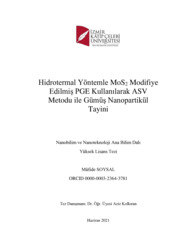Hidrotermal yöntemle MoS2 modifiye edilmiş PGE kullanılarak ASV metodu ile gümüş nanopartikül tayini Determination of silver nanoparticle by ASV method using hydrothermally MoS2 modified PGE
-
Eser Sahibi
Soysal, Müfide
- Tez Danışmanı Aziz Kolkıran
-
Tür
Yüksek Lisans
- Yayın Tarihi 2021
-
Yayıncı
Fen Bilimleri Enstitüsü
- Tek Biçim Adres https://hdl.handle.net/11469/2847
-
Konu Başlıkları
Nanobilim - Nanomalzemeler
Nanotechnology - Nano-science
ÖZETTıbbi biyouyumluluk, düşük toksisite, üstün elektriksel iletkenlik, yüksek elektrokatalitik aktivite gibi üstün özelliklere sahip olan gümüş nanopartikülün tanı ve görüntüleme tekniklerinde kullanımı oldukça önem arz etmektedir. Bu çalışma kapsamında, gümüş nanopartiküllerin elektrokimyasal tayini için grafen oksit ve MoS2 esaslı bir elektrot malzemesi geliştirilmiştir. Mükemmel 2D malzemeler olarak çalışabildiği keşfi yakın zamanda gerçekleşen MoS2, hidrotermal yöntem ile sentezlenerek grafen oksit ile modifiye edilmiş kalem grafit elektrodun (PGE) yüzeyine kaplanmıştır. AgNP'lerin elektrokimyasal tayininde çalışma elektrodu olarak hidrotermal MoS2 elektrot kullanılırken, 3'lü elektrot sisteminde referans ve karşıt elektrot olarak ise grafen oksit modifiye PGE elektrotlar kullanılarak, hızlı kullan at platformlardaki sensör uygulamalarına yeni bir yaklaşım getirilmiştir. Elde edilen bu yeni nesil MoS2 elektrodun gümüş nanopartiküle (AgNP) karşı duyarlı olduğu anodik sıyırma voltametrisi (ASV) ile tespit edilmiştir. AgNP iyonlarına karşılık ölçülen anodik yanıt ön biriktirme işlemiyle arttırılmış ve en uygun ortam şartında sinyalin 10 kat arttırdığı gözlemlenmiştir. Dizayn edilen elektrotun, grafen oksit ve MoS2 yardımıyla elektrot performansının iyileştirilmesini öneren yenilikçi bir çalışmadır. Diğer kaplama yöntemlerinden farklı olarak, PGE'nin MoS2 ile hidrotermal yöntemle sentezi, biyosensör uygulamaları için geliştirilen elektrotun tayin alt limitinde önemli bir iyileşme sağlamıştır. Hidrotermal MoS2 elektrodu ile AgNP duyarlılığının şartlandırılmış PGE elektroda ve grafen oksit daldırma elektroda karşı duyarlılığı nanoamper seviyelerinden mikroamper seviyelerine taşıyarak yüksek duyarlılıkta AgNP tayini yapabildiği tespit edilmiştir. Duyarlılık çalışmaları sonrasında anodik sıyırma yönteminin yüksek duyarlılığı nedeniyle ilgili yöntemin validasyonu çalışılmıştır. Anodik sıyırma voltametrisi için 16-75 pM doğrusal çalışma aralığı tespit edilmiştir. Belirlenen çalışma aralıkları için LOD seviyesi 9,43 pM seviyesinde tespit edilmiştir. LOQ değeri 31,45 pM olarak bulunmuştur. Belirlenen şartlar altında uygulanan yöntemin güvenilirliği, tekrarlanılırlığı ve kesinliği yüksektir.ABSTRACTThe use of silver nanoparticles, which has superior properties such as medical biocompatibility, low toxicity, superior electrical conductivity, and high electrocatalytic activity, in diagnostic and imaging techniques is very important. In this study, an electrode material based on graphene oxide and MoS2 was developed for the electrochemical determination of silver nanoparticles. MoS2, which was recently discovered to work as perfect 2D materials, was synthesized by hydrothermal method and coated on the surface of graphene oxide modified pencil graphite electrode (PGE). While a hydrothermal MoS2 electrode is used as the working electrode in the electrochemical determination of AgNPs, a new approach has been brought to sensor applications in fast disposable platforms by using graphene oxide modified PGE electrodes as reference and counter electrodes in the 3 electrode system. It was determined by anodic stripping voltammetry (ASV) that this new generation MoS2 electrode was sensitive to silver nanoparticle (AgNP). The measured anodic response to AgNP ions was enhanced by the pre-deposition process and it was observed that the signal increased 10 times under the most suitable environment condition. It is an innovative study that proposes to improve the electrode performance of the designed electrode with the help of graphene oxide and MoS2. Unlike other coating methods, the hydrothermal synthesis of PGE with MoS2 provided a significant improvement in the lower limit of detection of the electrode developed for biosensor applications. It has been determined that the sensitivity of AgNP with the hydrothermal MoS2 electrode can carry out high sensitivity AgNP determination by moving the sensitivity from nanoampere levels to microampere levels against the conditioned PGE electrode and graphene oxide immersion electrode. After the sensitivity studies, the validation of the relevant method was studied due to the high sensitivity of the anodic stripping method. A linear operating range of 16-75 pM was determined for the anodic stripping voltammetry. The LOD level was determined at 9.43 pM for the specified working ranges. The LOQ value was found to be 31.45 pM. The reliability, reproducibility and precision of the method applied under the specified conditions are high.
-
Koleksiyonlar
ENSTİTÜLER
FEN BİLİMLERİ ENSTİTÜSÜ

 Tam Metin
Tam Metin

